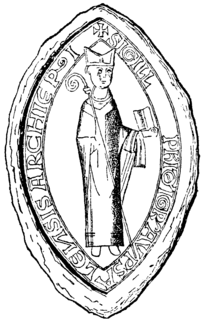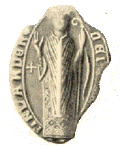
The Church of Sweden is an Evangelical Lutheran national church in Sweden. A former state church, headquartered in Uppsala, with 6.0 million baptised members at year end 2017 it is the largest Christian denomination in Sweden.

Eric "XI" the Lisp and Lame Swedish: Erik Eriksson or Erik läspe och halte; Old Norse: Eiríkr Eiríksson was king of Sweden in 1222–29 and 1234–50. Being the last ruler of the House of Eric, he stood in the shadow of a succession of powerful Jarls, especially his brother-in-law Birger Jarl, whose descendants ruled as kings after his death.

Henry was a medieval English clergyman. He came to Sweden with Cardinal Nicholas Breakspeare in 1153 and was probably designated to be the new Archbishop of Uppsala, but the independent church province of Sweden could only be established in 1164 after the civil war, and Henry would have been sent to organize the Church in Finland, where Christians had already existed for two centuries.

John I was a Swedish king elected in 1216.

Charles VII or Carl was ruler of Götaland, and then King of Sweden from c. 1161 to 1167, when he was assassinated.

Stefan was created the first Archbishop of Uppsala in Sweden in the year 1164, a post he held until his death.
Petrus was the third archbishop of Uppsala, Sweden, between 1187-1197.

The Archdiocese of Uppsala is one of the thirteen dioceses of the Church of Sweden and the only one having the status of an archdiocese.
The Battle of Lena occurred on January 31, 1208, and probably took place near Kungslena, which is located in the Tidaholm Municipality in Västergötland, Sweden. It was an important battle between the Danish-backed former King Sverker II of Sweden and Prince Eric. Eric's forces imposed a crushing victory; however in July 1210, Sverker returned with a second army and was killed in the Battle of Gestilren.
Magnus Minniskiöld was a medieval Swedish magnate from the House of Bjelbo. For posterity, he is best known as the father of the renowned statesman Birger Jarl, and the ancestor of the later Swedish kings. He is sometimes believed to have perished in the Battle of Lena in 1208, though the evidence is not conclusive.

The Diocese of Skara is the oldest existing diocese in Sweden, originally a Latin bishopric of the Roman Catholic church, and since Protestant reformation a Lutheran diocese of the Church of Sweden, with its seat at Skara in Västergötland. In 2014, it celebrated its 1000-year anniversary as a full diocese.
Thomas is the first known Bishop of Finland. Only a few facts are known about his life. He resigned in 1245 and died in Visby three years later.
Fulco was the first known missionary Bishop of Estonia. He was appointed in 1165 by Eskil, the Danish Archbishop of Lund. Before his appointment, Fulco was a Benedictine monk in the abbey of Moutier-la-Celle, near Troyes in France. His nationality is not known.

Rodulff (Rodulf) is claimed by a 15th-century chronicle Chronicon episcoporum Finlandensium to have worked as a missionary "bishop" in Finland after Bishop Henry had died in the 1150s. Rodulff was allegedly from Västergötland in Sweden.

Christina Hvide was a mediaeval Swedish Queen, queen consort of King Charles VII of Sweden and mother of King Sverker II of Sweden.
Nicholas I was Bishop of Schleswig between 1209 and 1233. Since 1192 he de facto, though not consecrated, officiated during the flight and following royal captivity of his predecessor Bishop Valdemar (1193–1206).




















